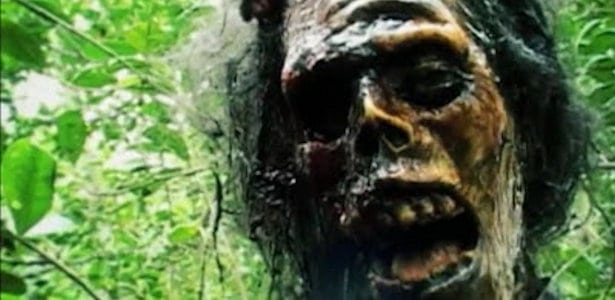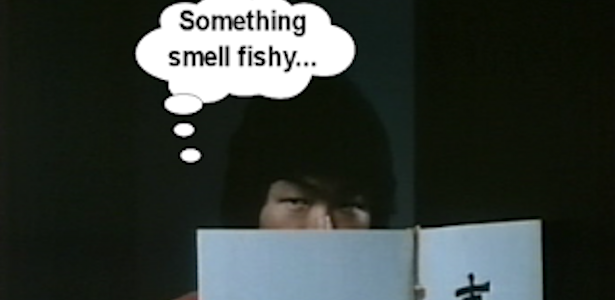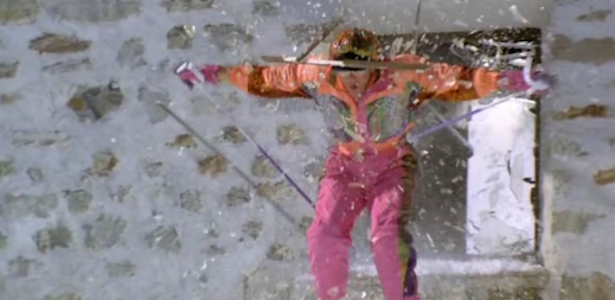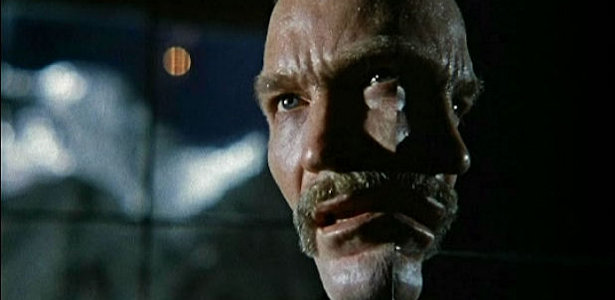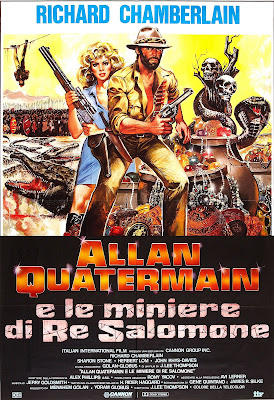During the peak of Cannon’s exploitation onslaught on theaters (and drive-ins) world-wide, there were a few precious stones that had been left unturned. This troubled Golan and Globus. While they continually tried to attack the problem of superhero films with CAPTAIN AMERICA and the terminal SPIDER-MAN license, they knew there was an area of opportunity in the mighty fedora festooned heroes of yore. With TREASURE OF THE FOUR CROWNS (1983) lining Cannon’s coffers with gold, the light bulb dinged above their collective craniums: why not take the original inspiration for the Indiana Jones movies and re-imagine it as an Indiana Jones knock-off? Brilliant! A few months after cashing in with Tony Anthony, a Frazetta-esque ad hit the trades.
As cool as the art is, it’s surprising that
a) Tobe Hooper was not attached to it.
b) The artwork was never used past this promo ad.
c) They went with the pith helmet instead of a fedora.
As for the choice of headwear, perhaps they feared being crushed by the weight of Lucas and Spielburg’s legal resources, as even Tony Anthony went sans chapeau and any other Jonesian accoutrement entirely in TREASURE OF THE FOUR CROWNS.
a) Tobe Hooper was not attached to it.
b) The artwork was never used past this promo ad.
c) They went with the pith helmet instead of a fedora.
As for the choice of headwear, perhaps they feared being crushed by the weight of Lucas and Spielburg’s legal resources, as even Tony Anthony went sans chapeau and any other Jonesian accoutrement entirely in TREASURE OF THE FOUR CROWNS.
Like many of Cannon’s high-concept films, this one took a while to get fully stocked up and ready to roll. By the time it was in front of the cameras The Boys clearly had gotten over their reticence to plunder Indy’s tomb. By 1985, hell, everyone was doing it!
Opening in an antique shop, a sufficiently geriatric professor Huston studies engravings on an ancient statuette that supposedly provide the directions to the legendary King Solomon’s Mines. Two men keenly look on, one is a white man in a suit (the professor’s assistant Rupert), the other (Kassam) you know is going to be a bad guy because he’s wearing a fez. Fez equals badguy, never forget that, it could save your life the next time you are pursuing relics of antiquity or are on a secret mission for your government. Suddenly another fez-wearing man, Dogati (John Rhys-Davies), bursts in and demands to know the location of the mines. When the professor Huston balks, Dogati swings a kukri knife down on a rope and a giant steel plate studded with spikes swings down from the rafters, impaling Rupert and effectively nailing him to a wooden door. At which point Kassam (Shaike Ophir) cries out “my door!” Wah-wah!
The basic narrative is that Jesse Huston (Sharon Stone) is looking for her father, Professor Huston, who has gone missing. As always, his reputation precedes him and Jesse figures the legendary Allan Quatermain (Richard Chamberlain) is the go-to guy here in North Africa… wait… wasn’t it supposed to be set in South Africa? Of course it would be much harder to poach Indy’s game if you didn’t have the appropriate local, in spite of the fact that Quatermain declares their arrival to be in Tongola! The introduction to our testy pair of bickering villains, Dogati and German Colonel Bockner (Herbert Lom), is followed by Jesse being kidnapped in the town market by some natives who roll her up in a carpet to bring to the pair of ne'er-do-wells. Quatermain gives chase, accosting innocent carpets and fighting on a runaway cart in a scene that is but one of many of the most blatant RAIDERS rip-offs imaginable. Hey, where’s the sword guy? I guess Chaimberlain must have had a supply of immodium on hand.
Upon entering the House of Isis, the shop that the opening scene took place in, Jesse and Quatermain find the remains of Rupert embalmed in a sarcophagus, which causes Jesse to holler at Kassam “where’s my father, you cheap-suited camel-jockey?!” I hate to get all politically correct, but it’s pretty damn funny how the KING SOLOMON’S MINES adaptations get more and more xenophobic as they progress. Here Umbopa is now Umbopo (Ken Gampu), and is played for laughs as a dumb native who is scared of “anything that doesn’t eat grass”. In addition Israeli-born producers Golan and Globus never missed an opportunity to take swings at other middle-eastern nationalities and the Allan Quatermain films took full use of that license to ill. If there ever is going to be peace in the middle-east, it sure as hell ain’t going to be on Golan and Globus' watch!
After blowing up the antique shop (no one is even scratched), and making their escape from the town Jesse says “I think you like helping a lady in distress!” to which Quatermain quips “Miss Huston, you are not in distress, you cause distress.” Cue thankfully brief romantic interlude of batting lashes and moon-eyes. Deciding that there has to be a better way to get across the vast country, Quatermain and company leap-aboard a speeding train, that just so happens to be transporting German troops! The creative forces behind this adaptation can be accused of a lot of things, but letting an opportunity for some classic adventure action slip by is not one of them. Here we get fights on top of the speeding train, fights underneath the speeding train and Quatermain being dragged behind the speeding train in a scene that is so obviously pilfered that you expect Quatermain to say “Train? What train?” Oh, and lets not forget the bit where he barges into a car full of German officers and bullshits his way out by yelling “let’s have some fuuuuuun!” and mustering up a rousing chorus of “The Camptown Ladies” with a bugle. Of course this is a song that every German stationed in Africa would know as it was made popular in 1850s New Orleans and is actually about an annual race held in Pennsylvania. Also, no “rescuing a professor from Germans on a moving African train” sequence would be complete without a German officer threatening to bust out his best DELIVERANCE reenactment on the old man before being humorously shot in the groin! Nothing says “hilarious” like attempted homosexual, age-differential rape and subsequent shotgun castration.
If this movie makes one statement, that statement would be “segues are for pussies!” This movie leaps from scene to scene without any need for interstitial drama, which is really fine by me. Leave that for the sequel. Leaping off the train, Quatermain and posse find themselves in a German airbase where they steal a plane and raze Dogati and German Colonel Bockner’s procession where poor Herbert Lom is saddled with dialogue such as “that’s all these primitive natives do! Run away… have you ever seen the German army run away?” (sees plane swooping in causing an elephant stampede) “Let me show you!” and runs off. You can almost hear him mutter “Ted Wass wasn’t so bad… we could do another sequel” as he trundles off.
 From there they land in a cannibal tribe’s giant cauldron filled with water and plastic vegetables (if only Quatermain had a Groucho Marx ventriloquist doll) and Jesse, terrified and screaming because she doesn’t realize that they will die of exposure long before that much water can be brought to a boil, hollers “I don’t want to die with dignity!” Not to worry, Sharon, you won’t. In what is possibly the most ridiculous excuse for a make out session ever committed to celluloid, after managing to tip the cauldron over, Quatermain and Jesse find that they cannot escape because a lion has decided to sit in front of the opening. So Quatermain and Jesse decide some serious smooching is in order. Once free of the pot, they are kidnapped by tree people who hang upside down on vines as a protest to the evil in the world. No really. Then are captured yet again, this time by the tribe that guards the mines. Oh shit! The mines! I forgot about them! Umbopa arrives to save the day at the same time the germans decide to shell the natives with mortars. Jesse is kidnapped by the usurper queen (yes it’s a female witchdoctor this time out) providing an excuse for everyone to run into the trap-laden, rubber monster-inhabited, papier-mâché mines. One of the traps is a room with a spiked ceiling that lowers down on Jesse, but at least there aren’t any giant bugs being squashed underfoot. Though we do find out a couple of facts, one of which is that Quatermain isn’t afraid of snakes. Chuckles all around.
From there they land in a cannibal tribe’s giant cauldron filled with water and plastic vegetables (if only Quatermain had a Groucho Marx ventriloquist doll) and Jesse, terrified and screaming because she doesn’t realize that they will die of exposure long before that much water can be brought to a boil, hollers “I don’t want to die with dignity!” Not to worry, Sharon, you won’t. In what is possibly the most ridiculous excuse for a make out session ever committed to celluloid, after managing to tip the cauldron over, Quatermain and Jesse find that they cannot escape because a lion has decided to sit in front of the opening. So Quatermain and Jesse decide some serious smooching is in order. Once free of the pot, they are kidnapped by tree people who hang upside down on vines as a protest to the evil in the world. No really. Then are captured yet again, this time by the tribe that guards the mines. Oh shit! The mines! I forgot about them! Umbopa arrives to save the day at the same time the germans decide to shell the natives with mortars. Jesse is kidnapped by the usurper queen (yes it’s a female witchdoctor this time out) providing an excuse for everyone to run into the trap-laden, rubber monster-inhabited, papier-mâché mines. One of the traps is a room with a spiked ceiling that lowers down on Jesse, but at least there aren’t any giant bugs being squashed underfoot. Though we do find out a couple of facts, one of which is that Quatermain isn’t afraid of snakes. Chuckles all around.
 From there they land in a cannibal tribe’s giant cauldron filled with water and plastic vegetables (if only Quatermain had a Groucho Marx ventriloquist doll) and Jesse, terrified and screaming because she doesn’t realize that they will die of exposure long before that much water can be brought to a boil, hollers “I don’t want to die with dignity!” Not to worry, Sharon, you won’t. In what is possibly the most ridiculous excuse for a make out session ever committed to celluloid, after managing to tip the cauldron over, Quatermain and Jesse find that they cannot escape because a lion has decided to sit in front of the opening. So Quatermain and Jesse decide some serious smooching is in order. Once free of the pot, they are kidnapped by tree people who hang upside down on vines as a protest to the evil in the world. No really. Then are captured yet again, this time by the tribe that guards the mines. Oh shit! The mines! I forgot about them! Umbopa arrives to save the day at the same time the germans decide to shell the natives with mortars. Jesse is kidnapped by the usurper queen (yes it’s a female witchdoctor this time out) providing an excuse for everyone to run into the trap-laden, rubber monster-inhabited, papier-mâché mines. One of the traps is a room with a spiked ceiling that lowers down on Jesse, but at least there aren’t any giant bugs being squashed underfoot. Though we do find out a couple of facts, one of which is that Quatermain isn’t afraid of snakes. Chuckles all around.
From there they land in a cannibal tribe’s giant cauldron filled with water and plastic vegetables (if only Quatermain had a Groucho Marx ventriloquist doll) and Jesse, terrified and screaming because she doesn’t realize that they will die of exposure long before that much water can be brought to a boil, hollers “I don’t want to die with dignity!” Not to worry, Sharon, you won’t. In what is possibly the most ridiculous excuse for a make out session ever committed to celluloid, after managing to tip the cauldron over, Quatermain and Jesse find that they cannot escape because a lion has decided to sit in front of the opening. So Quatermain and Jesse decide some serious smooching is in order. Once free of the pot, they are kidnapped by tree people who hang upside down on vines as a protest to the evil in the world. No really. Then are captured yet again, this time by the tribe that guards the mines. Oh shit! The mines! I forgot about them! Umbopa arrives to save the day at the same time the germans decide to shell the natives with mortars. Jesse is kidnapped by the usurper queen (yes it’s a female witchdoctor this time out) providing an excuse for everyone to run into the trap-laden, rubber monster-inhabited, papier-mâché mines. One of the traps is a room with a spiked ceiling that lowers down on Jesse, but at least there aren’t any giant bugs being squashed underfoot. Though we do find out a couple of facts, one of which is that Quatermain isn’t afraid of snakes. Chuckles all around.
Directed by the erratic and dwindling powers of J. Lee Thompson and co-scripted by sprained-brained exploitation maestro Gene Quintano (who gave us everything from Tony Anthony vehicles to POLICE ACADEMY sequels) and Cannon regular James R. Silke (responsible for 1985s AMERICAN NINJA), RAIDERS, I mean, KING SOLOMON’S MINES is pure form of exploitation film. An adaptation of the source material that provided inspiration for the blockbuster that you are now ripping off. There must be some sort of scientific name for that and if there isn’t there should be. Something like “The Cannon Paradox.” In fact, I think it's kind of exploitation genius usually reserved for Roger Corman and makes the film much more fun than it has any right to be.
The production values are pretty top-shelf, even by Cannon’s standards with great location photography, multitudes of extras, plenty of action and a great John Williams-esque score from low-rent alternative Jerry Goldsmith. You could probably argue that it has more to do with Indiana Jones than H. Rider Haggard; Umbopo (in addition to being oddly misspelled) is almost barely in the film and Captain Good and Sir Henry Curtis don't even factor in the equation at all, much less Foulata. The usurper Twala and the witchdoctor Gagool have been merged into a prunefaced witch, who does little but lead everyone into the mines at the end. After cutting all these characters, Quintano and Silke wisely decide to add some back in. Adding additional scenes with the professor drives the plot (or rather the action scenes) along and a pair of villains. Granted our villians could have at least been given a little bit more to do than just run around bickering with each other over the merits, or lack thereof, of Wagner and knackwurst, but having a WWI German army around and reworking the setting for cir. 1914 is actually a great idea and suits the original story well.
The production values are pretty top-shelf, even by Cannon’s standards with great location photography, multitudes of extras, plenty of action and a great John Williams-esque score from low-rent alternative Jerry Goldsmith. You could probably argue that it has more to do with Indiana Jones than H. Rider Haggard; Umbopo (in addition to being oddly misspelled) is almost barely in the film and Captain Good and Sir Henry Curtis don't even factor in the equation at all, much less Foulata. The usurper Twala and the witchdoctor Gagool have been merged into a prunefaced witch, who does little but lead everyone into the mines at the end. After cutting all these characters, Quintano and Silke wisely decide to add some back in. Adding additional scenes with the professor drives the plot (or rather the action scenes) along and a pair of villains. Granted our villians could have at least been given a little bit more to do than just run around bickering with each other over the merits, or lack thereof, of Wagner and knackwurst, but having a WWI German army around and reworking the setting for cir. 1914 is actually a great idea and suits the original story well.
So maybe the movie could have been a little less cheesy and have had a little more plot. Even so, it’s a pretty entertaining Indy rip-off that only just misses the mark on greatness. If only Corman had gotten to it first.





